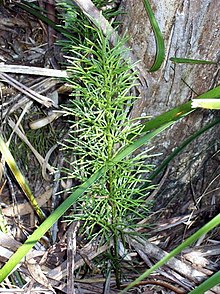| Pseudolycopodium | |
|---|---|

| |
| Growing near the Gloucester River, Barrington Tops, Australia | |
| Scientific classification | |
| Kingdom: | Plantae |
| Clade: | Tracheophytes |
| Clade: | Lycophytes |
| Class: | Lycopodiopsida |
| Order: | Lycopodiales |
| Family: | Lycopodiaceae |
| Genus: | Pseudolycopodium Holub |
| Species: | P. densum |
| Binomial name | |
| Pseudolycopodium densum (Rothm.) Holub | |
| Synonyms | |
| |
Pseudolycopodium is a genus of lycophyte in the family Lycopodiaceae with only one species, Pseudolycopodium densum, known as the bushy clubmoss. In the Pteridophyte Phylogeny Group classification of 2016 (PPG I), the genus is placed in the subfamily Lycopodioideae. Some sources do not recognize the genus, sinking it into Lycopodium. Pseudolycopodium densum is native to Australia, the North Island of New Zealand and New Caledonia. It is a spore-bearing vascular plant and grows up to a metre high. It is found in a wide variety of situations, often in high rainfall areas on sandy soils.
Taxonomy
The species was first described in 1807 by Jacques Labillardière, as Lycopodium densum. However, the name had already been used for a different species, so this name is illegitimate. Hence when Werner Rothmaler in 1944 placed the species in the genus Lepidotis as Lepidotis densa, this was the first legitimate use of the epithet. In 1983, Josef Holub placed the species in his genus Pseudolycopodium. This placement is accepted in the Pteridophyte Phylogeny Group classification of 2016 (PPG I), and by the Checklist of Ferns and Lycophytes of the World as of June 2024. Other sources retain the species in its original genus, Lycopodium, where the legitimate name is Lycopodium deuterodensum Herter.
Distribution and habitat
Pseudolycopodium (as Lycopodium deuterodensum) grows in open forest, scrub or heath in eastern New South Wales, southern Victoria, Tasmania (including Bass Strait Islands, Queensland, South Australia the North and Chatham Islands of New Zealand and in New Caledonia.
References
- ^ Hassler, Michael. "Pseudolycopodium". World Ferns. Retrieved 2 June 2024.
- ^ "Lycopodium densum Labill.", The International Plant Names Index, retrieved 8 December 2019
- ^ "Lycopodium deuterodensum Herter", Plants of the World Online, Royal Botanic Gardens, Kew, retrieved 8 December 2019
- ^ PPG I (2016), "A community-derived classification for extant lycophytes and ferns", Journal of Systematics and Evolution, 54 (6): 563–603, doi:10.1111/jse.12229, S2CID 39980610
- "Pseudolycopodium Holub", Plants of the World Online, Royal Botanic Gardens, Kew, retrieved 8 December 2019
- ^ Wilson, Peter G. "Lycopodium deuterodensum Herter". PlantNet - New South Wales Flora Online. Retrieved 9 December 2019.
- ^ "Lycopodium deuterodensum Herter". Atlas of Living Australia. Retrieved 9 December 2019.
- "Lepidotis densa Rothm.", The International Plant Names Index, retrieved 8 December 2019
- ^ "Lycopodium deuterodensum". Australian Plant Census. Retrieved 23 January 2021.
- ^ Entwistle, Timothy J. "Lycopodium deuterodensum". Royal Botanic Gardens Victoria. Retrieved 23 January 2021.
- ^ "Lycopodium deuterodensum". State Herbarium of South Australia. Retrieved 23 January 2021.
- ^ Jordan, Greg. "Lycopodium deuterodensum". University of Tasmania. Retrieved 23 January 2021.
- ^ "Lycopodium deuterodensum". New Zealand Plant Conservation Network. Retrieved 23 January 2021.
- ^ "Species profile—Lycopodium deuterodensum (bushy clubmoss)". Queensland Government Department of Environment and Science. 20 October 2014. Retrieved 23 January 2021.
| Taxon identifiers | |
|---|---|
| Pseudolycopodium | |
| Pseudolycopodium densum |
|
| Lycopodium deuterodensum |
|
| Lycopodium densum | |
| Lepidotis densa | |